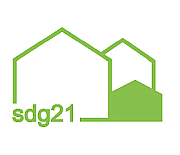Comparison of Sustainable Settlements and Urban Quarters in Germany
| State | Projects | WE* | Projects / | WE each | Inhabitants*** |
|---|---|---|---|---|---|
82 | 21.851 | 7,08 | 2.008 | 10.879.620 |
|
43 | 4.887 | 2,46 | 274 | 17.865.520 |
|
33 | 8.448 | 2,10 | 658 | 12.843.510 |
|
22 | 392 | 7,70 | 137 | 2.858.710 |
|
17 | 1.610 | 4,83 | 457 | 3.520.030 |
|
17 | 1.478 | 2,75 | 239 | 6.176.170 |
|
10 | 3.395 | 1,26 | 428 | 7.926.600 |
|
10 | 4.175 | 5,59 | 2.336 | 1.787.410 |
|
7 | 867 | 1,73 | 214 | 4.052.800 |
|
4 | 1.314 | 0,98 | 322 | 4.084.850 |
|
4 | 178 | 1,61 | 72 | 2.484.830 |
|
4 | 260 | 5,96 | 387 | 671.490 |
|
3 | 140 | 1,86 | 87 | 1.612.360 |
|
3 | 44 | 3,01 | 44 | 995.600 |
|
3 | 123 | 1,38 | 57 | 2.170.710 |
|
2 | 120 | 0,89 | 53 | 2.245.470 |
|
| Total | 254 projects in Dt. | 49,282 residential units | 3.09 projects/1 million p.e. | 600 dwelling units/1 million inhabitants | 82,175,680 PE in Dt. |
* Status: 30.9.2016
** Population - number of inhabitants of the federal states in Germany on 31 December 2015
Source: http://de.statista.com/…
Chronological overview
| Decade | Number of projects | Residential units |
|---|---|---|
| In the making | 39 | |
| 2020-2029 | 22 | |
| 2010-2019 | 75 | |
| 2000-2009 | 87 | |
| 1990-1999 | 113 | |
| 1980-1989 | 29 | |
| Realization before 1980 | 9 | |
| Not realized | 9 | |
| Total (without "Not realized"); Note 1) | 325 |
Note: while settlements and neighbourhoods with ecological-sustainable objectives from 1970 to 2009 are most likely fully inserted in the database, there are probably gaps in the period from 2010 onwards. One issue here is that due to the normality of the measures, many of the settlements no longer explicitly refer to themselves as 'ecological settlements'. They are also no longer published in the trade/media because there tends to be less innovation compared to the projects between 1980 and 2000. In this respect, I assume that the realised housing units of sustainable settlements will be somewhat higher from 2010 onwards.
Scale
| Sizes- Category | Sizes- Assignment (GR) | Residential units (total) | Number of Settlements |
|---|---|---|---|
| XXL | from 1,000 | 42.029 | 16 |
| XL | 500 to 999 | 7.670 | 15 |
| L | 200 to 499 | 4.075 | 16 |
| M | 100 to 199 | 3.905 | 33 |
| S | 30 to 99 | 3.275 | 62 |
| XS | 3 to 29 | 1.244 | 84 |
| (XXS)* | < 3 | (9) | (8) |
| Total: (incl. XXS) | 61.014** (62.207) | 226*** (226) |
* Building / no settlement
** Status: 1.3.2017
*** Status: 2.1.2019, only realised settlements and quarters are counted
Inhabitants | Settlement |
|
|---|---|---|
11.142.000 | 1 |
|
5.590.000 | 19 |
|
81.890.000 | 250 |
|
63.228.000 | 5 |
|
5.414.000 | 1 |
|
65.697.000 | 2 |
|
11.280.000 | 1 |
|
60.918.000 | 4 |
|
16.768.000 | 57 |
|
5.019.000 | 2 |
|
8.462.000 | 46 |
|
38.543.000 | 1 |
|
10.524.000 | 1 |
|
8.139.600 | 13 |
|
9.517.000 | 14 |
|
9.944.000 | 2 |
|
| Sum* Europe | 412.075.600 | 419 |
* As of 30.9.2016. In Europe, not all settlement and neighbourhood projects with sustainability objectives are fully recorded or documented in the web database. While the project directory in Germany should be relatively complete, the European countries have not been systematically updated since 2003.
Archive:
Comparison of sustainable settlements in Germany as of 2009
